Picture this—you’re making a soup that’s supposed to simmer gently, but instead, boiling bubbles are splattering all over the stovetop. Sound familiar? If you’ve been there (and most of us have), you know the challenge of finding that sweet spot between too hot and not hot enough.
Simmering technique is one of those essential cooking techniques that seems simple but holds massive culinary power. It’s a foundational skill for anyone wanting to level up their cooking and craft dishes that pack incredible flavor. Whether you’re making a hearty beef stew, a delicate broth, or a luscious marinara, simmering is the technique that brings out the magic.
This guide will break down simmering—from the basics to advanced techniques—and give you practical tips and recipes to help you become a simmering pro.
What is Simmering Technique?
Simmering technique is a moist heat cooking method that gently cooks food in liquid at a temperature between 185°F to 205°F. Unlike boiling, which is vigorous and rapid, simmering is calm and controlled with small, gentle bubbles just breaking the surface. It’s like the quiet hum of cooking compared to boiling’s loud, aggressive roar.
Why this specific temperature range? Because it’s hot enough to cook food thoroughly and extract maximum flavor but gentle enough to protect textures and prevent overcooking. If you’ve wondered how your favorite restaurant achieves those perfectly tender stews, simmering is likely the answer.
This overlooked technique is a hero in moist heat cooking, drastically improving everything from stews and soups to curries and sauces.
Why Simmering Technique is Important in Cooking
At first glance, the slow and steady pace of simmering might feel tedious compared to the hustle of boiling or searing. But the results? Worth every second.
Preserves Texture
Simmering is gentle, which means your delicate ingredients (like poached eggs or fish) don’t fall apart or turn rubbery. Even heartier ingredients like root vegetables retain their shape and texture without turning mushy.
Boosts Flavor
Give soup or sauce time to simmer, and the flavors start to concentrate and meld together beautifully. It’s science at work—heat helps break down proteins and vegetables, releasing their aromas and deepening flavors.
Tenderizes Tough Cuts
Ever wondered how those tough, sinewy cuts of meat turn into buttery bites in a stew? Simmering slowly breaks down connective tissues, giving you tender, fall-apart results.
Versatile Across Cultures
From the French coq au vin to Indian dal or a classic American beef stew, simmering is the unsung hero of cuisines across the globe.
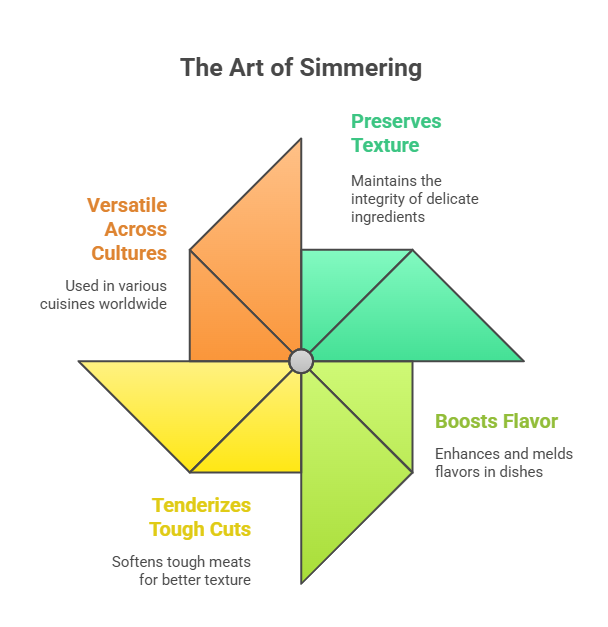
How to Achieve the Perfect Simmer
If you’re ready to turn up the heat (well, not too much heat), follow these steps to get your simmering game just right:
Step 1: Choose the Right Pot or Pan
A good pot is the foundation of a great simmer. Go for sturdy materials like stainless steel or enameled cast iron—these distribute heat evenly and avoid hot spots.
Step 2: Get the Liquid Boiling First
Start by bringing your water, stock, or sauce to a boil. Once it’s boiling, reduce the heat to low or medium until you see those signature gentle bubbles forming.
Step 3: Monitor the Heat
The key to a consistent simmer lies in maintaining the ideal temperature. Adjust your stove dial incrementally until you hit that sweet spot. Pro tip? If you’re unsure, use a thermometer to hover around the 185°F-205°F range.
Step 4: Stir Occasionally
Periodic stirring ensures even cooking and prevents foods from sticking to the bottom of the pot. This is especially important for thicker recipes like stews or sauces.
Step 5: Use a Lid Strategically
Want to speed up the cooking process? Cover the pot. But if you’re reducing liquid (like in marinara), go lid-free or leave it slightly ajar.
Troubleshooting Simmering
- Too hot? Lower the heat and stir to cool it down. If things are boiling over, you’ve crossed into boiling territory.
- Too cold? Turn up the heat slightly and wait for those gentle bubbles to reappear.
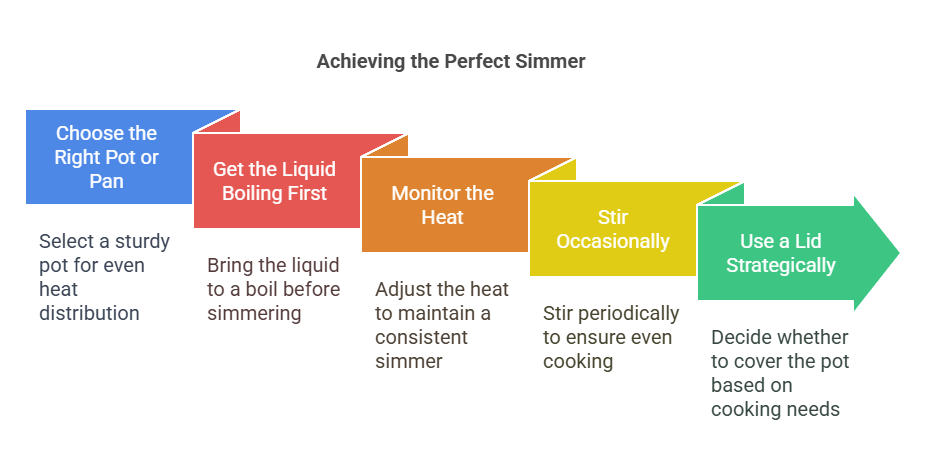
Common Simmering Mistakes to Avoid
Even seasoned cooks slip up sometimes, so watch out for these common simmering pitfalls:
- Over-boiling Instead of Simmering
Many home cooks mistake a rapid boil for a simmer, but the aggressive heat can toughen proteins and muddy flavors.
- Neglecting to Taste and Stir
Simmering is not a “set it and forget it” method. Regular tasting ensures balanced seasoning, and stirring prevents sticking or burning.
- Using the Wrong Pot Size
Overcrowding a small pot hinders even heat distribution, while a pot that’s too large can make it hard to maintain a proper simmer.
- Ignoring the Lid Factor
Not using a lid—or using it incorrectly—can upset liquid levels and affect flavor concentration.
- Confusing “Low Heat” with Simmering
Simmering technique is about controlled bubbling, which doesn’t always equate to turning the stove to the lowest setting.
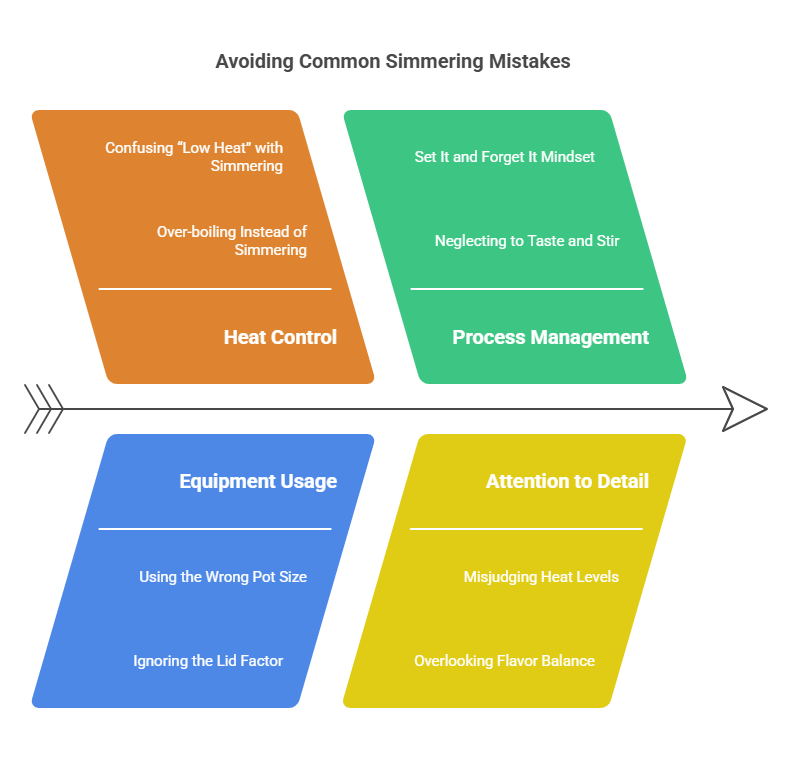
Simmering Techniques and Applications
Simmering isn’t one-size-fits-all. Different recipes call for unique simmering techniques:
- Gentle Simmer
Best for poaching fish, making broths, or creating delicate sauces. Think small, slow-moving bubbles.
- Rapid Simmer
Ideal for reducing liquids like gravy or thickening sauces. Look for fast but controlled bubbling.
- Applications in Other Methods
- Braising uses simmering to cook food partially submerged in liquid.
- Slow cooking mimics the long, low-heat effect of simmering.
Recipes That Rely on Simmering Technique
Want to dip your toes into simmering? Try these recipes:
- Classic Chicken Soup
A soothing bowl of chicken soup is the ultimate simmering recipe—start by sautéing onions, carrots, and celery, then add broth and chicken. Simmer until flavors meld and the chicken is tender.
- Beef Stew with Root Vegetables
Long, slow simmering transforms beef chuck into melt-in-your-mouth goodness.
- Marinara Sauce from Scratch
Simmer canned tomatoes with garlic, basil, and olive oil to create a rich, flavorful sauce.
- Indian Lentil Dal
Simmer lentils with aromatic spices like turmeric and cumin for an easy, protein-packed meal.
- Poached Pears in Red Wine
Simmering sweet pears in wine, sugar, and spices creates an impressive dessert.
Health Benefits of Simmering Technique
Simmering technique isn’t just easy—it’s healthy too!
- Nutrient Retention: Simmering technique helps preserve vitamins and minerals better than boiling.
- Lower Fat Content: It requires less added fat compared to frying or roasting.
- Maintains Food Integrity: Natural textures and structures stay intact, making dishes more wholesome.
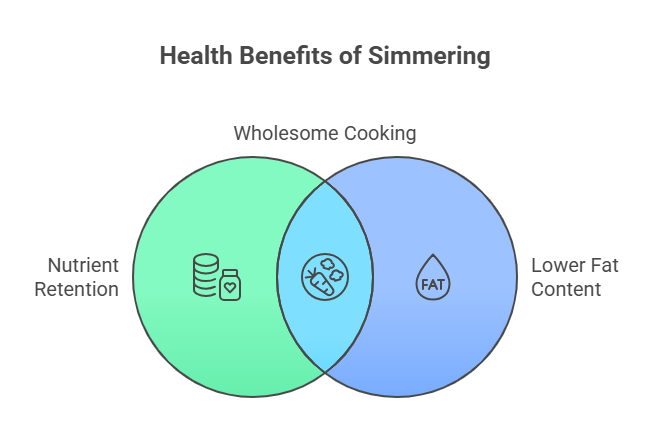
Tips to Enhance Your Simmering Skills
Simmering technique is an art, so keep these tips handy:
- Practice Patience: Good results take time.
- Build Layers of Flavor: Sear meats and deglaze the pan before simmering.
- Experiment with Aromatics: Toss in herbs, garlic, and spices for deeper, richer flavors.
- Control Liquid: Adjust evaporation by partially covering the pot.
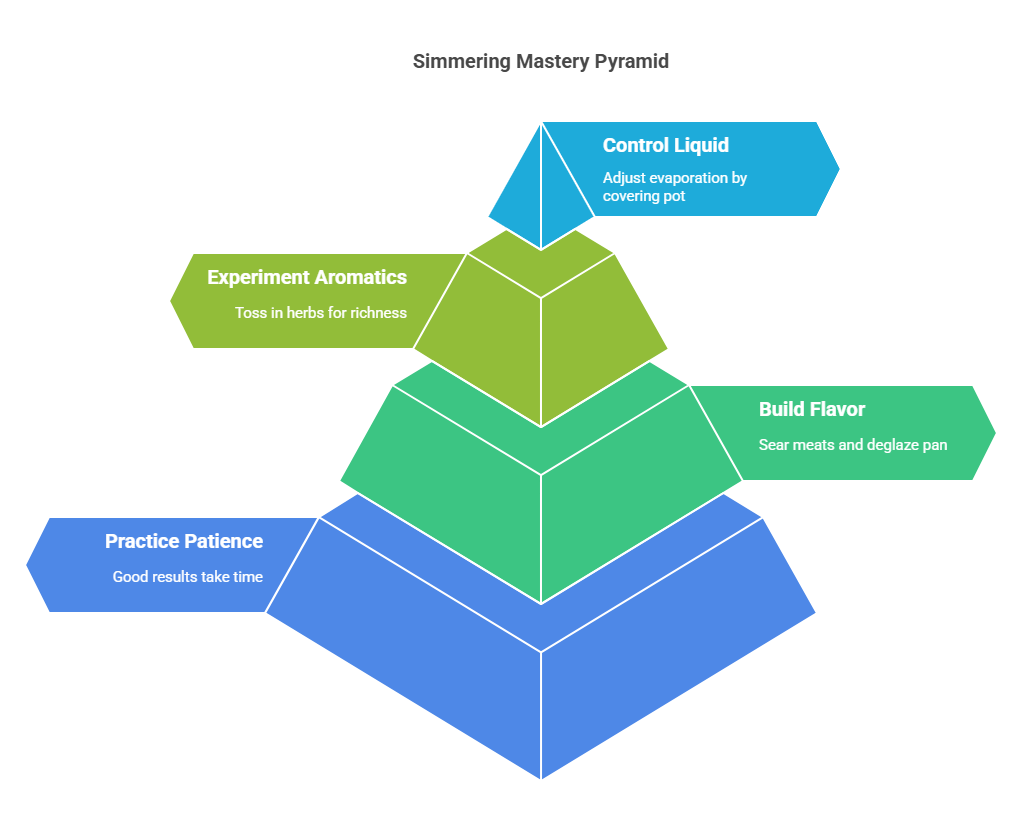
Simmering Technique vs Other Moist Heat Cooking Methods
How does simmering technique compare to other techniques? Here’s a quick breakdown:
- Boiling is faster but harsher, making it suitable for pasta or hard vegetables.
- Poaching is even gentler than simmering, used for eggs or fish.
- Steaming retains nutrients but lacks the flavor-infusion of simmering.
Frequently Asked Questions About Simmering Technique
What temperature is considered a simmer?
Between 185°F and 205°F.
Can you simmer without a lid?
Yes! Use a lid to speed up cooking or go lid-free to reduce liquid.
How can I tell if I’m simmering?
Look for gentle, consistent bubbles—not a rolling boil.
What foods are best cooked by simmering?
Soups, stews, curries, sauces, grains, and legumes.
Final Thoughts
Simmering is the heart of many comfort foods. It blends flavors, tenderizes ingredients, and brings out the best in every bite. Whether you’re a beginner or a seasoned pro, mastering this simple yet powerful technique will transform how you cook.
Try one of our recipes, share your simmering success, or comment below on your go-to simmering tricks. Happy simmering!
📌 Stay connected with us!
- Follow us on Instagram: @RoastedKitchen25 for daily cooking inspiration.
- Tag us in your creations using #RoastedKitchensimmering—we’d love to see what you make!
Subscribe to our newsletter for exclusive recipes, expert tips, and kitchen hacks straight to your inbox!

Hi, I’m Mayaz Ahsan!
As a passionate cook, storyteller, and food enthusiast, I combine my love for travel, farming, reading, and teaching to bring you insightful culinary tips and stories. Welcome to Roasted Kitchen – I’m thrilled to share this journey with you!

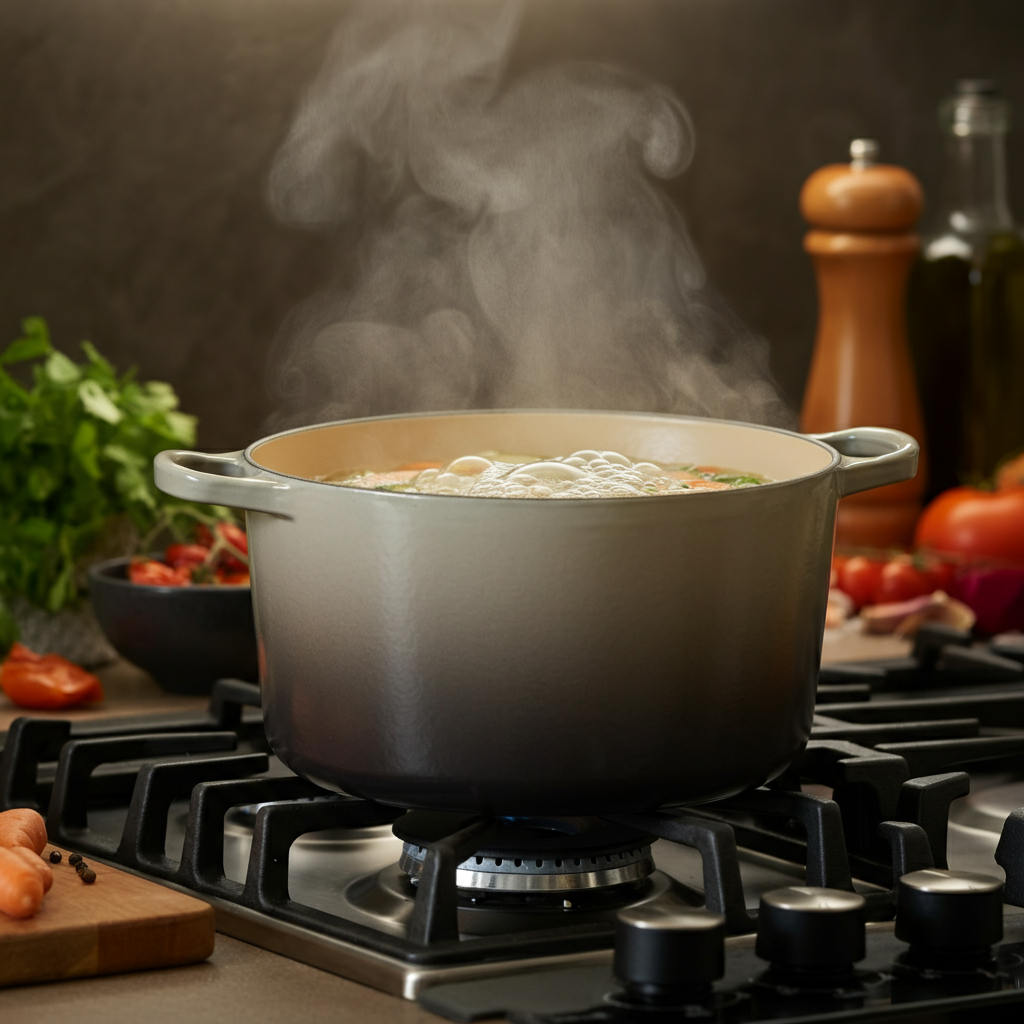








 Subscribe to our free newsletter for tips, tutorials, and insights!
Subscribe to our free newsletter for tips, tutorials, and insights!